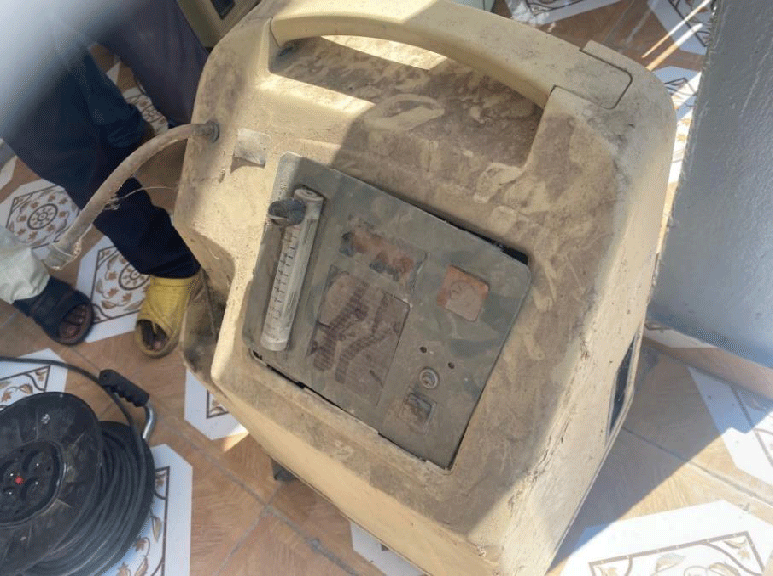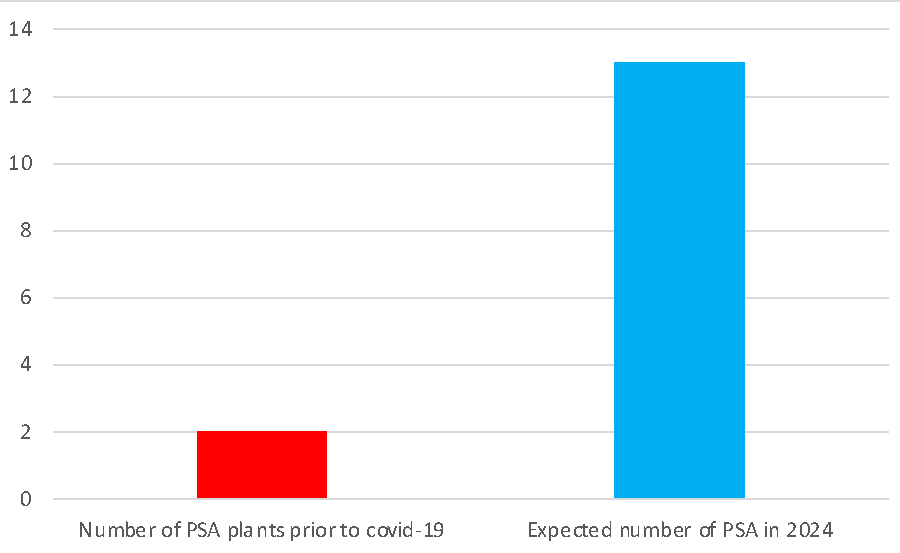Archives of Community Medicine and Public Health
Oxygen needs to be met in chad: Resilience, lessons learned, challenges and perspectives
Edison Maombi and Jean-Bosco Ndihokubwayo*
Cite this as
Maombi E, Ndihokubwayo JB (2023) Oxygen needs to be met in chad: Resilience, lessons learned, challenges and perspectives. Arch Community Med Public Health 9(3): 052-054. DOI: 10.17352/2455-5479.000202Copyright License
© 2023 Maombi E, et al. This is an open-access article distributed under the terms of the Creative Commons Attribution License, which permits unrestricted use, distribution, and reproduction in any medium, provided the original author and source are credited.Lack of medical oxygen has contributed to a large number of avoidable fatalities globally, which have escalated as a result of the COVID-19 pandemic. At the start of the pandemic, one of the major challenges that almost all countries faced was access to oxygen to treat their patients, who were often doomed to certain death in the absence of this product. Chad had a total of two oxygen production plants, all installed in Ndjamena, with low production capacity to meet high demand. Oxygen concentrators, which are an appropriate and attractive means of administering oxygen in healthcare facilities where there is a shortage of cylinders or a distribution network, were also not sufficient, and most of them were out of use due to the lack of proper preventive maintenance. To overcome this situation, Chad is improving its capacity for medical oxygen through the installation of new Oxygen plants, maintenance and repair of broken Oxygen concentrators as well as the training of maintenance technicians. This paper shares the experience of Chad in its efforts to improve the availability of oxygen for the management of respiratory diseases, as well as the benefits and challenges to consider when planning for increased access to medical oxygen in similar settings.
Introduction
When treating patients at all levels of the healthcare system, including during surgery, trauma, heart failure, asthma, pneumonia, and maternity and child care [1], oxygen is an essential medication [2,3]. Pneumonia alone kills 800,000 people per year. It is expected that the provision of oxygen therapy could avert 20% - 40% of these deaths [1]. The healthcare system’s impact on treating all illnesses acute or chronic may often include oxygen respiration in order to enhance lung respiratory response through stimulating cell metabolism and the immune system to respond more effectively.
Since the appearance of COVID-19, oxygen has proven to be one of the essential drugs in the care of patients suffering from this disease. The COVID-19 pandemic has increased global demand for oxygen and made oxygen supply delivery more critical than ever. Oxygen demand has risen to 1.1 million cylinders in low- to middle-income nations alone [1].
Despite being a critical therapy for a variety of illnesses, oxygen access has long been overlooked in healthcare planning. Almost half of all hospitals in low- and middle-income nations have insufficient medical oxygen or none at all [4].
During the first phase of the pandemic, WHO focused on increasing oxygen supply in the most susceptible nations by purchasing and distributing oxygen concentrators and pulse oximeters. WHO also provided technical assistance and, in some cases, large-scale procurement of oxygen supplies. This includes pressure swing absorption plants, which can meet increasing oxygen demands in larger healthcare facilities. Some of the succussed projects are the medical oxygen plants inaugurated in Bhutan [5], Paraguay [6] and in Chad [7].
Cost, human resources, technical training, and a continuous and reliable power supply are all specific hurdles to oxygen systems [8].
In addition to supporting COVID-19 patients, WHO's enhanced efforts to offer oxygen assistance are already helping to treat other diseases, leading to overall health system strengthening. Improving access to oxygen treatment should already be a priority for every country [9].
Chad health system
The national health system in Chad is pyramidal at three levels (central, intermediate, and peripheral), each of which has elements that contribute to the implementation of the national health policy.
At the top of the pyramid, the central level, consisting of the central government and other national structures, develops health policies and strategies. At the center of the pyramid, the intermediate level provides coordination, support, and monitoring for implementation by transforming national health policy strategies into technical programs to be applied at the district health level. The intermediate level consists of 23 Provincial Health Delegations, Provincial Health Boards, provincial health institutions (Provincial Health Schools, Provincial Supply Pharmacies, Provincial Hospitals), etc. At the base of the health pyramid, we find the peripheral level of the system with its health districts that play the role of operational units. Each district is subdivided into areas of health responsibility. Each area is served by health centers. Each district has a district hospital, which is the first reference level for health centers. This peripheral level is crucial for the implementation of primary health care. The peripheral level includes 150 Health Districts, 126 of which are functional and distributed in the 23 Provincial Health Delegations. It is the linchpin of the health system and is responsible for the implementation of primary healthcare activities. The health districts include 114 district hospitals, 1856 areas of responsibility, and 1672 functional health centers, representing a theoretical health coverage of 90.09% in 2019 (SDSIS) [10].
The theoretical health coverage at the national level is 87.17%, and the average radius of action to reach a health center is 15 km and a hospital is 66 km. The coverage in Prenatal Consultation (PNC) is 59.95%, and that in PNC 4 is 17.64%. For deliveries, the proportion of assisted deliveries throughout the territory is 31.19%, with a caesarean section rate of 1.54%. For pregnant women who have received at least 2 doses of tetanus vaccine, it is 82.73%. In terms of health personnel, in 2021, the doctor/inhabitant ratio is 1 doctor for 22,533 inhabitants, and the State-certified midwife/Women of childbearing age ratio is 1 midwife for 6,382 women of childbearing age. About 168 health facilities have the infrastructure in an advanced state of degradation. The share of the health budget in 2021 is 7.25% of the share of the general state budget. The first 5 reasons for consultation in health structures are Malaria (25.84%); Upper respiratory tract infection (3.60%); Moderate lower respiratory tract infection (3.59%); Malnutrition (2.94%); and Trauma (1.90%). These pathologies alone represent 68.81% of all the health problems notified to the curative consultation [11].
Progress made
Chad's health system has demonstrated resilience in terms of the availability of medical oxygen with the help of its partners, particularly the WHO, which coordinated the response.
Several measures have been implemented, including the building of new oxygen production facilities and the repair of broken-down oxygen concentrators with hospital maintenance professionals trained. Figure 1 illustrates the condition of a poorly maintained oxygen concentrator as found in some hospitals. A total of 103 service technicians from 23 provinces around the country underwent practical training on repairing oxygen concentrators, and 54 of the 94 broken-down oxygen concentrators were repaired [12].
From the two oxygen production plants initially installed in Ndjamena, the predictions indicate that thirteen oxygen production units with a total capacity of more than 385.6 m3/hour will be established within the country by 2024 [13]. Figure 2 shows the country’s number of oxygen production plants prior to and during COVID-19 [13].
Lessons learned
Transforming pandemic investments into long-term respiratory care services necessitates integrated efforts across funding, health system and device infrastructure, operations and maintenance, clinical training, information systems, policy development, and advocacy.
Properly maintained oxygen concentrators can provide a highly effective low-cost easy-to-use solution for health facilities in developing countries.
Challenges and perspectives
Although the country has made progress in terms of oxygen acquisition, the operation of all these oxygen production plants will incur costs (fuels for the generators, maintenance, etc.) that will necessitate good thought and vision in order to sustain these achievements, which may face management problems and come to an end.
The safe transportation of oxygen cylinders is another challenge since the provincial sites will function as supply pools for other nearby provinces. A management guide, as well as the presence of well-trained biomedical engineers and technicians, is also a key lever for the proper operation of the equipment and the long-term viability of these investments.
It is appropriate, if not essential, for Chad to develop a directive on the management of the various oxygen production sites and to strengthen its human resource capacities by training more technicians and biomedical engineers to take care of its biomedical equipment in general and its oxygen production plants in particular. Acquisitions made during this COVID-19 pandemic require it.
Conclusion
Increasing Access to Medical Oxygen will benefit patients of all ages, from premature newborns and young children with respiratory illnesses to patients requiring surgery and the elderly with chronic health issues. Medical oxygen will most likely be a critical therapy during any future pandemic.
The authors thank the Minister of Public Health and Prevention of Chad for his collaboration and vision to improve the well-being of the population.
- WHO. The life-saving power of medical oxygen. Geneva: World Health Organization. 2021 (https://www.who.int/news-room/feature-stories/detail/the-life-saving-power-of-medical-oxygen).
- WHO, World Health Organization Model List of Essential Medicines for Children – 8th List, 2021. Geneva: World Health Organization; 2021. https://www.who.int/publications/i/item/WHO-MHP-HPS-EML-2021.03.
- WHO, World Health Organization Model List of Essential Medicines – 22nd List, 2021. Geneva: World Health Organization; 2021. https://www.who.int/publications/i/item/WHO-MHP-HPS-EML-2021.02
- PATH, Oxygen resources: Sustainable access to save lives.
- WHO, South-East Asia Regional Office, The two WHO-supported medical oxygen plants that were inaugurated in Bhutan. https://www.who.int/southeastasia/news/detail/09-08-2023-two-who-supported-medical-oxygen-plants-inaugurated-in-bhutan.
- PAHO/WHO. On the medical oxygen plants improving health care in Paraguay - PAHO/WHO | Pan American Health Organization. https://www.paho.org/en/stories/medical-oxygen-plants- improve-health-care-paraguay
- WHO. Chad Country Office, Deux (2) centrales à oxygène pour sauver des vies dans le sud du Tchad. (https://www.afro.who.int/fr/countries/chad/news/deux-2-centrales-oxygene-pour-sauver-des-vies-dans-le-sud-du-tchad).
- Stein F, Perry M, Banda G, Woolhouse M, Mutapi F. Oxygen provision to fight COVID-19 in sub-Saharan Africa. BMJ Glob Health. 2020 Jun;5(6):e002786. doi: 10.1136/bmjgh-2020-002786. PMID: 32532759; PMCID: PMC7295423.
- Duke T, Graham SM, Cherian MN, Ginsburg AS, English M, Howie S, Peel D, Enarson PM, Wilson IH, Were W; Union Oxygen Systems Working Group. Oxygen is an essential medicine: a call for international action. Int J Tuberc Lung Dis. 2010 Nov;14(11):1362-8. PMID: 20937173; PMCID: PMC2975100.
- Carte sanitaire du Tchad 2019-2023. https://reliefweb.int/report/chad/carte-sanitaire-du-tchad-2019-2023.
- Yearbook of Health Statistics of Chad, Volume A, 35th Edition, May 2023.
- WHO, Chad Country Office, Reports: Training of maintenance technicians on repair and maintenance of oxygen concentrators, 2022-2023.
- WHO, Sante Info-Tchad Bulletin d’information Annuel du Bureau pays de l’OMS au Tchad, No 4 Novembre, 2022. https://www.afro.who.int/sites/default/files/2022-12/Bulletin%20Sant%C3%A9%20Info%20OMS%20N%C2%B0004_Final.pdf
Article Alerts
Subscribe to our articles alerts and stay tuned.
 This work is licensed under a Creative Commons Attribution 4.0 International License.
This work is licensed under a Creative Commons Attribution 4.0 International License.




 Save to Mendeley
Save to Mendeley
